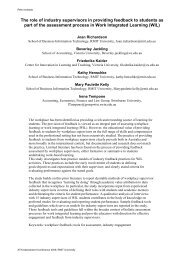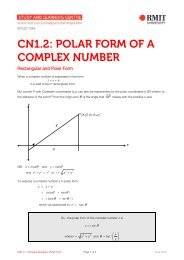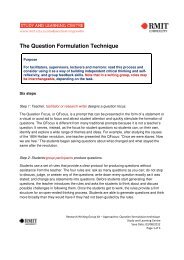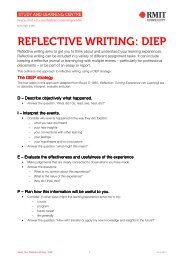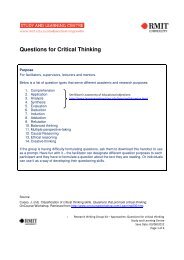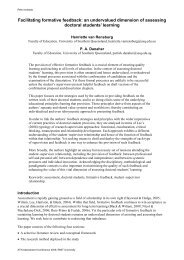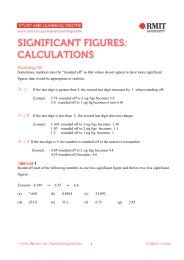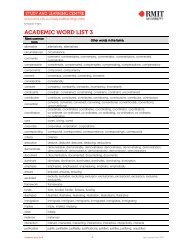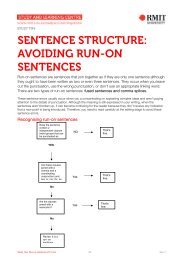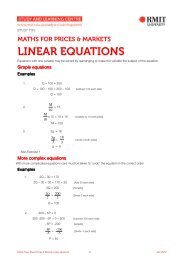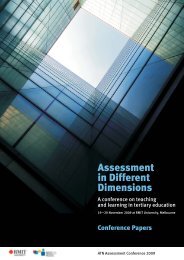student feedback and leadership - Office for Learning and Teaching
student feedback and leadership - Office for Learning and Teaching
student feedback and leadership - Office for Learning and Teaching
Create successful ePaper yourself
Turn your PDF publications into a flip-book with our unique Google optimized e-Paper software.
Part B: Building Leadership Capacity - SET: Mathematics & Geospatial Sciences ART Report<br />
10.3 Background <strong>and</strong> Project Focus<br />
What courses were the subject of this project? Give total <strong>student</strong> numbers<br />
<strong>and</strong> breakdown how it was taught at the start of the project. Include any<br />
other relevant in<strong>for</strong>mation about the profile of the <strong>student</strong>s <strong>and</strong> the<br />
context of delivery.<br />
The following courses which have large enrolments were considered:<br />
MATH2123<br />
This course was taught to 220 first year <strong>student</strong>s in the first semester.<br />
The <strong>student</strong>s in this course are from 5-6 different disciplines with varying TER<br />
scores depending on the discipline. This introduces considerable variation in<br />
their mathematical abilities. The course is taught via the following approaches:<br />
face-to-face lectures, mathematics practice classes <strong>and</strong> Statistics computer<br />
labs. The teaching materials <strong>for</strong> the course are posted on the <strong>Learning</strong> Hub<br />
via blackboard so that during lectures <strong>student</strong>s have time to listen <strong>and</strong> then<br />
write the solutions to the problems listed in their weekly lecture notes,<br />
practice sheet or lab assignments.<br />
The course material is composed of 50% Mathematics <strong>and</strong> 50% Statistics.<br />
At the beginning of the project the mathematics component was assessed<br />
only through a number of weblearn tests where <strong>student</strong>s could repeat each<br />
weblearn test to a maximum of 10 times until they achieved a score of 80%.<br />
Only then, are they permitted to attempt the next weblearn test. The statistics<br />
component was assessed through a: 70% final exam (open book), a 10%<br />
computer assignment that would require the <strong>student</strong>s to answer a set<br />
of questions that covered all topics in the course by using the Statistical<br />
computer package, MINITAB. For each question on the computer assignment,<br />
<strong>student</strong>s were asked to generate r<strong>and</strong>om data enabling each <strong>student</strong> to work<br />
with a different data set to minimize plagiarism. They had one weblearn test<br />
weighted 10%, where <strong>student</strong>s could do similar online practice quizzes as<br />
many times that they wanted <strong>for</strong> practice but could only attempt the test once.<br />
The final 10% was allocated to being up-to-date with their designated weekly<br />
problems from their text book. These problems were ticked off (but not<br />
marked) in their working note book every other week. To achieve the maximum<br />
10% <strong>student</strong>s were required to have done the assigned problems every week.<br />
Doing so would enable them to have extensive practice on topics that<br />
were covered during that week.<br />
MATH2114<br />
This is a course taught to 220 first year <strong>student</strong>s in the second semester.<br />
The <strong>student</strong>s in this course are from one discipline with high TER scores,<br />
there<strong>for</strong>e their mathematical ability is almost uni<strong>for</strong>m. The course is taught<br />
via the following approaches: face-to-face lectures, mathematics practice<br />
classes <strong>and</strong> statistics computer labs. The teaching materials <strong>for</strong> the course are<br />
posted on the <strong>Learning</strong> Hub via Blackboard. This group are taught in a lecture<br />
venue where there are no writing facilities, there<strong>for</strong>e, the solutions to lecture<br />
notes problems are also posted on the <strong>Learning</strong> Hub via Blackboard which<br />
means during lectures <strong>student</strong>s have time to listen more <strong>and</strong> write very little.<br />
Page 135



